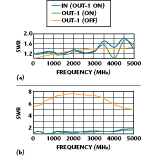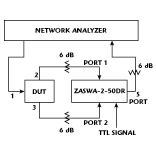A Three-channel Vector Modulator with Reference Channel
Merrimac Industries Inc.
West Caldwell, NJ
A new and unique packaging technology has been introduced for commercial and military microwave components and subsystems. Multi-Mix packaging methodology is a unique process based on fluoropolymer composite substrates for application to microwave multilayer ICs and micro-multifunction modules (MMFM). Multi-Mix technology enables filter, multiplexers, MMICs and other active and passive circuits to be packaged individually or cascaded into supercomponents for mixer/preamplifiers, vector modulators, complex antenna feed-distribution networks, phased-array beamformers or components for monopulse receiving systems.
The technology is similar to an application-specific IC for RF/microwave applications. It employs a platform strategy modular architecture that integrates mathematical, electromagnetic, thermal and mechanical modeling capabilities on contemporary PCs, permitting total analysis of the microwave enclosure to be performed prior to actual hardware fabrication. The benefits of this process technology lie in the ability to integrate many circuit functions into a smaller volume. The resulting components feature weight and size reductions, improved performance and quality, less risk and cost savings.
The Multi-Mix Process
The patent-pending Multi-Mix process begins with commercially available polytetrafluoroethylene (PTFE) composite, copper-clad laminate material having inherently low loss and low dielectric constant microwave properties. The fusion bonding of multilayer structures provides a homogeneous dielectric medium for superior electrical performance at microwave frequencies. No sheet adhesive or prepreg is required although they may be used selectively according to the application. The bonded layers may incorporate embedded semiconductor devices, MMICs, etched resistors, passive circuit elements and plated-through via holes to form a three-dimensional subsystem enclosure that requires no further packaging. The MMFM structure is a total integrated packaging solution. The small footprint, low profile unit is rugged and lightweight, and the external surface-mount format is compatible with microstrip or coplanar waveguide planar transmission lines.
A low z-axis coefficient of thermal expansion (CTE) (close to that of copper) ensures reliability of plated-through holes. Controlled x-/y-plane thermal expansion, together with a low expansion modulus, affords good reliability of surface-mounted devices in the most severe thermal cycling and thermal shock environments. Furthermore, a low and uniform thermal coefficient of dielectric constant coupled with the material's low CTE produces consistent electrical performance over a wide operating temperature range.
Complex microwave circuit patterns and transmission-line geometries may be chemically photo-etched on the copper, maintaining dimensional tolerances of 0.0030" +/-0.0005". Incorporation of thin-metal-film-etched resistors is routinely accomplished with accuracies of five percent, allowing power dissipation greater than discrete chips. Indexing holes for layer-to-layer assembly alignment are precision machined or drilled into each board. Layer-to-layer plated-through holes are realized with a minimum diameter of 0.005" and typical aspect ratios of 20:1 on holes 0.010" and larger. The process capability is certifiable to ISO 9001, MIL-P-55110 and IPC-HF-318A specifications.
Active device attachments may be embedded in cover-layer cavities to provide environmental protection and allow pre-cap inspection and test. Pick and place of discrete components is possible on array panels up to 12" x 18" with the potential to accommodate flip-chip and ball-grid array packages. Operating frequency capability extends through Ka-band.
When fabricating a bonded multilayer assembly, the stacked layers are placed in an alignment fixture to which carefully controlled, elevated pressure and temperature are applied to meet the substrate fusion bonding requirements. After cooling, edge plating for electromagnetic interference (EMI) shielding and ground plane integrity is performed. Finish platings for environmental protection include immersion tin, fused tin/lead and nickel/gold.
The Three-channel Modulator
One good example of Multi-Mix technology is a three-channel vector modulator assembly with a reference channel designed and manufactured for a military Global Positioning System application involving search-and-rescue operations. The component is used in a beamformer assembly for an adaptive antenna.
The vector modulator assembly consists of three dynamic, continuously variable vector modulators, one static modulator, four directional couplers, a four-channel RF summing network and a single-pole, three-throw absorptive switch multiplexer. The assembly has four RF inputs (CH1, CH2, CH3 and REF), two RF outputs (sum and element), six modulator control inputs (I1, Q1, I2, Q2, I3 and Q3), six feedback control inputs (PI1, PQ1, PI2, PQ2, PI3 and PQ3) and six element control inputs (A, B, C, D, E and F). Figure 1 shows the assembly's simplified block diagram.
Each RF input passes through a 15 dB coupler before entering a vector modulator. The coupled signals are the element outputs for each channel. These outputs are fed to the switch multiplexer, which provides matched terminations to the couplers and allows the selection of a single element output by means of the element control lines. Element selection switching supports built-in test equipment operations. The 15 dB coupler in line with the reference channel is terminated and does not feed into the multiplexer.
Each of the three dynamic vector modulators is composed of an input quadrature hybrid, two biphase attenuators and a power combiner. The static modulator differs only in that variable attenuators are replaced by fixed attenuators (that is, the FETs are replaced by fixed resistors). Each modulator is continuously variable by means of the in-phase (I) and quadrature (Q) inputs. Each I and Q input has an associated feedback input to compensate for the FETs' relative resistance. The vector rotation for each modulator is 360°.
Each biphase attenuator consists of a quadrature hybrid and a GaAs FET subassembly. In this case, the FETs are used as voltage-variable resistors. The signal is fed to the input of the quad hybrid and reflected out of the isolated port by the resistance at the 0° and 90° ports. Minimum insertion loss is seen at short- and open-circuit conditions. A 180° phase inversion occurs at maximum attenuation when the resistance equals 50 W. Linearization of the I and Q control voltage is accomplished using a programmable read-only memory chip.
Each modulator output is fed into an output summing network comprising a four-way, in-phase power combiner. Summation of the reference- and modulated-channel vectors provides a single modulated RF output. Electrical specifications for the vector modulator are listed in Table 1 .
|
Table I | ||
|
RF Input Frequency (MHz) |
1227± 10 |
1575± 10 |
|
RF Input power (dBm) |
-70 to +10 |
-70 to +10 |
|
SWR (max) (all RF ports, all phases) |
2 |
2 |
|
Image rejection (dB) (min) |
30 |
30 |
|
Carrier isolation (dB) (min) |
30 |
30 |
|
Insertion loss, any sum, |
16 |
15 |
|
Insertion loss, any sum, |
5 |
4 |
|
Element control voltage (V) |
-5/0 |
-5/0 |
|
I and Q voltage range (V) |
-4 to 0 |
-4 to 0 |
|
Reference channel resistors (W ) |
24 |
24 |
|
Directional coupler (dB) |
15 |
15 |
|
Outline dimensions (") |
3.50 x 1.50 x 0.21 | |
|
Temperature Range (° ) |
-40 to +85 | |
The Modulator's Mechanical Structure
The outline dimensions for the vector modulator assembly are 3.50" x 1.50" x 0.21", as shown in Figure 2 . The unit's weight is 1.6 oz. The input/output interface is surface mount and compatible with microstrip or coplanar waveguide. The vector modulator assembly is edge plated to provide EMI shielding and ground plane integrity. The surface finish is fused tin/lead, and the assembly is compatible with pick-and-place, infrared reflow solder attachment.
Figure 2 . The unit's weight is 1.6 oz. The input/output interface is surface mount and compatible with microstrip or coplanar waveguide. The vector modulator assembly is edge plated to provide EMI shielding and ground plane integrity. The surface finish is fused tin/lead, and the assembly is compatible with pick-and-place, infrared reflow solder attachment.
The physical structure of the vector modulator assembly is an eight-layer, microwave IC composed of etched copper circuits and etched Ohmega-ply film resistors. Plated-through signal via holes form the interconnection between layers, while ground vias channelize signal paths and provide isolation. Thermal vias are used to conduct heat away from active devices and achieve a thermal resistance of 0.96°C/W. The FET subassemblies and switches are embedded in the multilayer assembly and attached using high temperature solder reflow techniques. The Multi-Mix process features fusion bonding to achieve the reliability and complexity of buried interconnections in the vector modulator assembly. Fusion bonding also allows the formation of a custom substrate thickness while using commercially available material. Layers 1 and 2 form a stripline structure (er = 6.15) incorporating the 15 dB couplers, power combiners and summing network. The next stripline structure (formed by layers 3, 4 and 5) contains the quadrature hybrids. Device attachment is performed on layer 6, and a cover is formed by layers 7 and 8.
The multilayer circuits utilize high stability PTFE/ceramic composite substrates having dimensional stability matched to copper and aluminum. These substrates range in dielectric constant from 2.9 to 10.2. The substrate material has a low CTE in the z-axis (24 ppm/°C), which matches that of aluminum and is very close to that of copper (17 ppm/°C), thus ensuring excellent reliability of the plated-through holes (over 5000 temperature cycles from -55° to +125°C without a single failure). A low tension modulus (x-/y-axis) greatly reduces the stress applied to solder joints and allows the solder joint to be constrained by a minimum amount of low CTE metal (6 ppm/°C), further increasing surface-mount reliability.
Modulator Performance
To illustrate performance, the unit's phase and amplitude balance are plotted for eight-phase-shift keying modulation of an individual channel. Phase balance vs. frequency is shown in Figure 3 , and insertion loss and amplitude balance vs. frequency are shown in Figure 4 .


Conclusion
A three-channel vector modulator with reference channel was designed and fabricated using the Multi-Mix process technology. The assembly demonstrates the ability of this new packaging methodology to reduce size and weight while maintaining good microwave performance and reliability. Other RF/microwave components have been successfully constructed using this process with similar results.
Merrimac Industries Inc.,
West Caldwell, NJ
(973) 575-1300.
